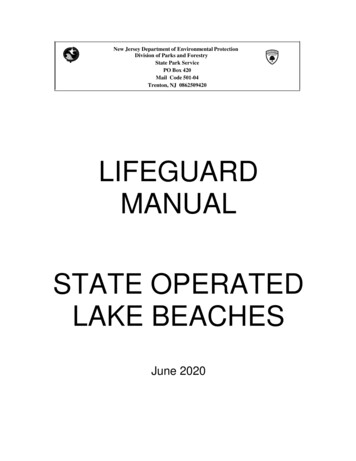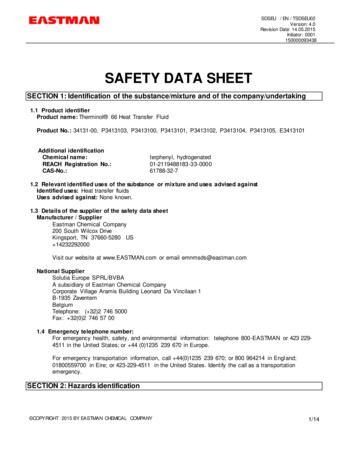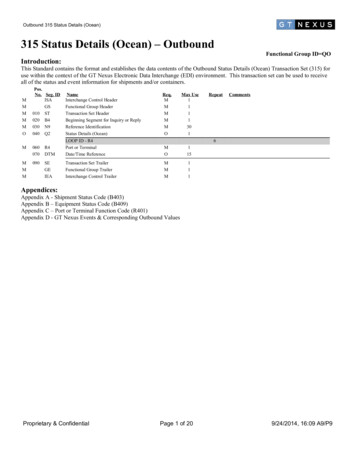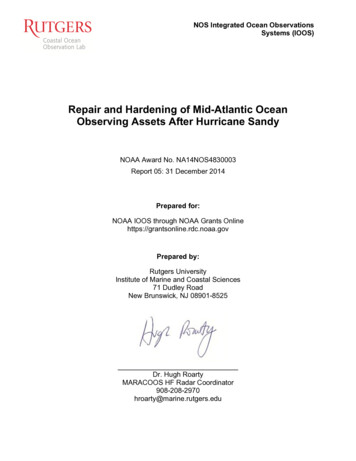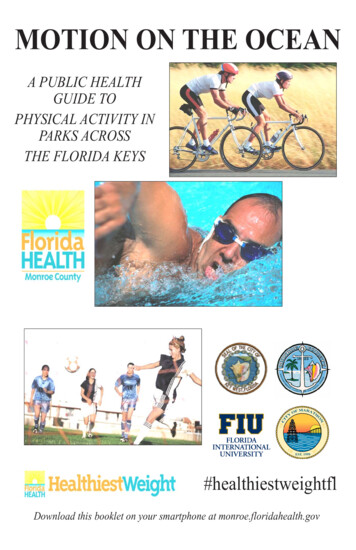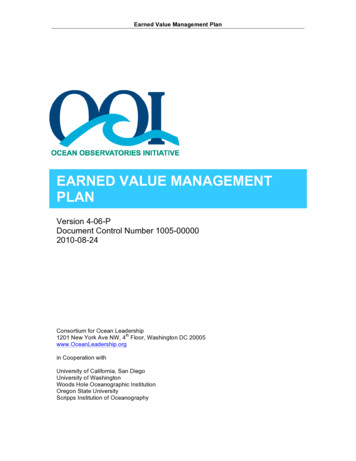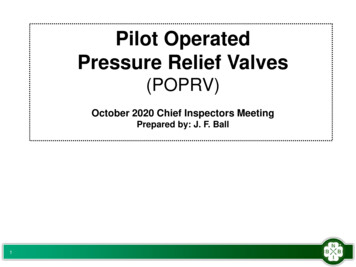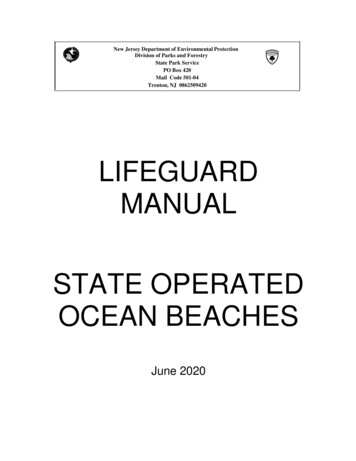
Transcription
New Jersey Department of Environmental ProtectionDivision of Parks and ForestryState Park ServicePO Box 420Mail Code 501-04Trenton, NJ 0862509420LIFEGUARDMANUALSTATE OPERATEDOCEAN BEACHESJune 2020
TABLE OF CONTENTSForeword .3Required Reading for all NJ State Lifeguards .4PERSONNELI.II.III.IV.V.VI.Responsibility .6Training.8Public Relations .12Personal Injury on Duty.12Pathogen Exposure .12Information and Guidelines on Sun Protection nnel Regulations .22Uniform Regulations .24Flotation Devices .25Beach/Bathing Regulations .26Enforcement of Beach & Bathing Regulations .27Windsurfing Regulations .27Disabled Ramp Regulations .28Locker Room Regulations .28Public Informational Flags .28Disciplinary Policy .29EQUIPMENT AND REGULATIONS AND USESI.General Equipment Regulations .31II.Lifeguard Stands.31III.Portable Signs and Flags .32IV.Kayaks .32V.Rescue Boards .43VI.Surf Boats .50VII. Torpedo Buoys.55VIII. Line Buoy .58IX.Backboard and Cervical Collars .59X.Pocket Masks and Bag Valve Masks .75XI.Beach Wheelchair .75XII. Personal Watercraft.76XIII. All Terrain Vehicle.83XIV. Mask, Fins, Snorkel .85XV.Emergency Oxygen .86XVI. AED .861
II.Opening and Closing .88Communications .88Summoning Aid .92Lost Child/Person .92Missing Child/Person .93Red Alert Submersion.93Off Beach Rescue/First Aid .96Disturbances .97Lightning .97Guarding .98Rescue Procedure and Coverage .101Miscellaneous Hazards .105Rescue Without Lifesaving Equipment .106OCEAN BEACH TERMINOLOGYI.Ocean Water Terminology .108ACKNOWLEDGEMENT .1112
FOREWORDLifeguards are responsible for the safety and well being of the patrons who swim at their beach. Tomeet this responsibility, a lifeguard needs:1.Knowledge of rescue procedures coupled with swimming ability.2.A thorough familiarity with lifeguard equipment and the techniques used in its application.3.The confidence to analyze and act effectively to situations either in the water or on the beach.4.Trained eyes so that visual control can be maintained over the area of responsibility.5.To be physically fit, to meet the physical demands of the job.A lifeguard also has the responsibility to help ensure that each patron has the optimum opportunityto enjoy the public facilities.The information contained within this manual is the result of years of experience, research, andpractical application. It is based on common sense, and the basic components of open-waterlifeguarding. The rules pertaining to the public are based on providing recreation, health, and safetyfor the majority. The personnel rules are not unreasonable. The rules are for the protection of thepublic and the lifeguards, while maintaining that degree of discipline necessary for the effectiveexecution of a lifeguard’s duties.3
REQUIRED READING FOR ALL LIFEGUARDS1.Seasonal Employee Manual (State Park Service)2.Lifeguard Manual (State Park Service)3.First Aid/CPR/AED Participant’s Manual (American Red Cross) Revised 2016 ISBN978-1-58480-665-3, or American Safety and Health Institute Advanced First AidManual4.CPR/AED for the Professional Rescuer (American Red Cross)Revised 2016 ISBN 978-0-9983745-3-6, or American Healthand Safety Institute BLS materials5.Lifeguarding Textbook (American Red Cross)ISBN 0-86536-181-96.Island Beach State Park Lifeguard Radio Procedures7.Open Water Lifesaving USLA Manual Second EditionIBSN 0-536-73735-5American Red Cross Textbooks are available from the following source:Staywell1-800-667-29684
PERSONNEL5
I.RESPONSIBILITYA.Area Superintendent - The Area Superintendent is responsible for all activities within thearea and is the highest authority.B.Water Safety Supervisor (WSS) - There is a Water Safety Supervisor in each region. Thisperson assists the area Superintendents to ensure that all bathing areas are safely maintainedand managed. As a member of the regional staff this position is directly responsible to theRegional Superintendent.C.Lifeguard Supervisor Captain - The Lifeguard Supervisor is responsible for maintaining asafe water front and transmitting orders, policies and procedures from the area Superintendentto the lifeguard staff. As administrative head of the lifeguard staff, the Supervisor is responsiblefor:1.Organizing, training, scheduling, and supervising the lifeguards2.Enforcing all rules and regulations3.Evaluating each lifeguard4.Beach management5.Maintaining required records6.Daily inspection of equipment and supplies7.Daily inspection of beach area, First Aid Room, and all facilities assigned to thelifeguards8.Reporting needed repairs or new/replacement equipment9.The morale of the lifeguards10.D.E.Reporting all safety and serious disciplinary problems to the area SuperintendentLieutenant 1.In the absence of the Supervisor, he/she performs the duties as outlined in “C” above.2.He/She carries out all tasks assigned by Supervisor.3.Responsible for efficient performance and training of lifeguards he/she is assigned tosupervise.4.Responsible for safety and efficiency of assigned area.5.Carries out Lifeguard duties.Lifeguard Sergeant - Normal duties are:6
F.1.Carries out orders issued by the Lieutenant and Supervisor.2.Responsible for efficient performance and training of the lifeguards they areassigned to supervise.3.Responsible for safety and efficiency of assigned area.4.Carries out Lifeguard duties.Lifeguard Duties 1.Pass all sections of lifeguard employment test prior to being hired.2.Stay alert and scan patrons in the bathing area.3.Safeguard and regulate the conduct of patrons in the bathing area to preventconditions that may lead to an accident.4.Enforce beach and bathing area regulations.5.Performs rescues, CPR and rescue breathing when necessary.6.Performs first aid at a level consistent with American Red Cross First Aid except in thecase of a broken bone or dislocation. In the case of broken bone or dislocation thelifeguard will keep the victim stationary and comfortable until the ambulance arrives. Theambulance crew will splint and move the victim. ONLY if the situation requires thelifeguard to move the victim immediately, the fractures must be immobilized.7.Maintain and efficiently utilize lifeguard equipment.8.Assist in maintaining a clean beach, employee area and First Aid Room.9.Assist in maintaining records.10. Meet training requirements.11.G.Perform other duties as required or assigned.Lifeguard First Aid Duties1.Maintain first aid supplies in proper quantities and complete inventory every two weeks.2.Check and refill first aid kits at the start of each day.3.Maintain strict cleanliness in the first aid area.4.Maintain first aid equipment in a clean, neat, and workable condition.5.Keep the Lifeguard Supervisor informed on the status of first aid supplies andequipment.7
H.II.6.Fill out and file a first aid report on all first aid administered.7.Maintain a log of incoming and outgoing telephone calls.8.Review Red Cross First Aid and CPR/AED Books and/or ASHI BLS and AdvancedFirst Aid periodically throughout the season.9.Wear gloves while performing first aid or CPR. If the situationdictates, more protection (gown and face shield) must be worn.Unacceptable Lifeguard Conduct - Any let down in performance of duties that creates anunsafe situation, can not be tolerated, and may lead to disciplinary action or dismissal.TRAININGA.First Aid/CPR - All lifeguards must have current American Red Cross Professional CPR/AED, First Aid, Bloodbourne Pathogen, and Oxygen Administration certificates and/or AmericanSafety and Health Institute BLS, Advanced First Aid and Bloodbourne Pathogens certificates, andbe competent in the use of backboards and cervical collars. These skills will be reviewedthroughout the season during the in-service training.B.Physical - A lifeguard must meet physical training requirements each week.1.The Lifeguard Supervisor will be responsible in seeing the physical training requirementsand its records are carried out. The Lifeguard Supervisor may designate a physicaltraining officer to administer physical training; however, the Lifeguard Supervisor isultimately responsible.2.Each Lifeguard must complete physical training requirements each week. Substitution ofone requirement for another is only permitted with prior permission of the LifeguardSupervisor. On occasion a guard may be exempted from physical trainingrequirements. EXAMPLE: Lifeguard did not work all 5 days or bathing area is closed.3.On occasion a guard may have to do more than the minimum requirements in a week.4.Physical training may only be done during working hours when it does not compromisethe safety of the bathers.5.Lifeguards who work less than a 5-day week must complete a minimum of two trainingrequirements per day.6.Failure to complete required training will result in disciplinary action or dismissal.7.Lifeguard officers may allow guards to perform exercises individually or conductstructured sessions that include all guards. Sessions involving all guards must be priorto 10:00 a.m.8.Description of Required Physical Training8
SWIMMinimum requirement is four 500-meter swims in at least 500-meter increments.When a Lifeguard swims a long distance from the bathing area or where boats may bepresent, extra safety precautions should be taken.PADDLEMinimum requirement is three 1000-meter kayak/rescue board paddles in at least1000-meter incrementsRUNMinimum requirement is three miles a week in at least one-mile increments.ROWINGMinimum requirement is one 1000-meter row completed all at once.C.Rescue Procedures and Techniques - All rescue techniques and emergency procedures will belearned. As much time as necessary will be spent in acquiring and maintaining proficiency inthese skills.D.Lifeguards are responsible for knowing all procedures, skills, and regulations in the lifeguardmanual and passing an examination on that manual. Any person caught cheating on themanual test will be dismissed.E.Lifeguards are responsible for all material in the Seasonal Employee Manual.F.The following outlines the training to be received by new guards. This material must bereviewed by returning lifeguards prior to carrying out lifeguard functions. All guards willreview these skills and procedures throughout the season.ALL LIFEGUARDS ARE SUBJECT TO TESTING IN THE ABOVE SKILLS, AND THEIR PHYSICALCONDITION, AT ANY TIME.9
TRAINING PROGRAMORIENTATION:1.Objectives and Goals of Training Program2.Using the lifeguard manual to achieve the objectives and goals of thetraining program.3.Chain-of-Command and Scope of Authority4.Introduction to Equipment and Facilitiesa.Torpedo Buoys (rescue cans/buoys, torps)b.Line Buoyc.Kayaks/Rescue Boardd.Boats and Personal Watercrafte.All Terrain Vehiclef.First Aid and CPR Equipmentg.Backboards and Related Equipmenth.Location of all Supplies and Equipmenti.Signs (Text, Location, Etc.) and Flags5.Introduction to “Job of a Lifeguard”a.b.c.d.e.f.g.h.6.Skills and performance requiredResponsibilityPhysical Fitness and In-Service TrainingPreventative LifeguardingPublic RelationsEnforcement of Beach & Bathing Area RegulationsPersonnel RegulationsDisciplinary PoliciesCommunicationsa.b.c.d.Hand and Whistle SignalsTelephone ProceduresRadio ProceduresMegaphone and Public Address Use7.Environmental Hazards8.Ocean & Beach ConditionsLifeguarding Skills and Procedures1.Scanning2.Rescue Procedures and Emergency Coverage3.Rescues with equipmenta.Torpedo Buoyb.Line Buoy10
c.d.e.f.g.BoatKayak/Rescue BoardConscious VictimsUnconscious Victims, discuss in water rescuebreathing with protection. (Ref. Open WaterLifesaving USLA Second Edition Pg. 264).Multiple Victims4. Rescues without equipmenta. Basic Fundamentalsb. Technique Variations5.Personal Watercraft (Designated Personnel Only)a.b.c.d.Safety and HandlingRescue ProceduresOff Beach UseMaintenance6. All-Terrain Vehicle (Designated Personnel Only)a.b.c.d.Safety and HandlingRecommended UsesOff Beach UseMaintenance7.Mask, Fins, Snorkel8.Water Search9.Submersion10.Lost and Missing Persons11.Emergency Care and Transportation of ill and injureda. American Red Cross Professional CPR/AED (Bloodborne PathogenTraining and oxygen administration will be covered in the CPR class.)and/or ASHI BLS.b. American Red Cross First Aid and/or ASHI Advanced First Aidc. Neck and Back Injuries in the Waterd. Review pages 207 to 210 Open Water Lifeguarding USLA Manual 2ndEdition in the unlikely event of having to interact with a helicopter. Payparticular attention to static electricity when lowering a cable andlanding.Examinations1.Written Examinations on all phases2.Practical Examinations on all phases11
3.III.Timed SwimsPUBLIC RELATIONSLifeguards must remember that they work for a public service agency. They areto be courteous at all times. Personal contact with a patron is preferable toyelling, whistling or using a megaphone when possible. Lifeguards will enforcethe rules for the area. Any difference of opinion will be referred to a lifeguardofficer, other supervisor, area office, or State Park Police. Use of any offensiveor obscene language by a lifeguard will not be tolerated. A lifeguard’s conduct isa reflection upon the State of New Jersey, thereforelifeguards are expected to conduct themselves during duty hours and off dutyhours in such a manner as to bring credit upon themselves, fellow employees, andthe area in which they work.IV.PERSONAL INJURY WHILE ON DUTYWhenever the service of a doctor, dentist, or hospital is needed because of aninjury sustained while working, the area office must be notified prior to receivingservices, when possible. The office will direct you to the nearest approved medicalfacility. If the facility is closed and urgent care is needed, proceed to the nearesthospital. Bills for doctors, the hospital, medication, etc., will be paid by theState of New Jersey in these cases. Check with the area office before payingwith your own money or seeing a doctor of your choice. An employee First AidReport must be filled out and signed by the immediate supervisor for any injurysustained on the job.V.BLOODBOURNE PATHOGEN EXPOSUREPathogens are disease-causing agents such as bacteria, viruses and other agentsthat present themselves in blood and other potentially infectious materials(OPIM). Viruses include: Human Immunodeficiency (HIV), Hepatitis B,Hepatitis C, and others. OPIM are defined as semen, vaginal secretion,cerebrospinal fluid, synovial fluid, plural fluids, pericardial fluid, peritonealfluid, amniotic fluid, unfixed tissues or organs, and any body fluids visiblycontaminated with blood.When a lifeguard is performing first aid, CPR or other duties, he or she maybe exposed to Bloodborne Pathogen or OPIM.A. Pathogen exposure is defined as any contact with blood or OPIM of anotherperson that may enter the body through a needle stick, open cut, sore, or mucousmembranes such as eyes or oral cavities. Contact with saliva, urine, feces, vomit,or sputum visibly contaminated with blood is considered an exposure.1. If exposure occurs:a. Immediately wash effected area with soap and water. Antiseptic may beapplied if available. The sooner the contamination is washed off, theless chance of infection.b. Immediately notify the area superintendent who must direct you to the12
nearest hospital or medical facility for treatment. The superintendentwill fill out a RM-2 and contact appropriate state offices.c. Go to approved medical facility immediately, explain exposure, andthat this is a Workman’s Compensation-related injury. If approvedfacility is closed or approved facility information is not available go tothe nearest hospital. Do not delay.2. When medical care has been completed for pathogen exposure the effectedlifeguard must submit the following documentation from the medical providerto:Office of Occupational Health and Safety(OOHS) PO Box 416Trenton, NJ 08625Fax: 609-984-2488a. That he/she has been informed of any medical testing resultsb. That he/she has been educated about medical conditions that canresult from exposure to blood or OPIM.B. To prevent pathogen exposure a lifeguard:1. Will be trained in Red Cross and/or ASHI Bloodbourne Pathogen andDisease Prevention along with OOHS Bloodbourne Exposure ControlPlan for State Lifeguards and OSHA Bloodbourne Pathogen Regulation29 CFR 1910. 1030. This training will be done yearly.a. OSHA Bloodborne Pathogen standards are available online b. OOHS Complete Bloodborne Pathogen Exposure Control Planfor State Lifeguards is available at training and park office.2. Must always use universal precautions whenever contact with bodyfluids is anticipated. Universal Precautions requires the employer andemployee to assume that all human blood and body fluids are infectiousfor HIV, Hepatitis, or other Bloodborne Pathogen.3. Must always use Personal Protective Equipment (PPE) includingdisposable latex free gloves and resuscitation protective device whenperforming first aid, CPR, or whenever contact with body fluids orblood is anticipated. Gowns, and eye protection are also available.4. Dispose of PPE after each use and each victim. The same PPE shouldnot be used on multiple victims.5. Hands should be washed if possible before providing care. Hands mustbe washed immediately following removal of gloves. If soap and wateris not available other washing methods such as alcohol-based sanitizersmust be used. Sanitizers are only a temporary solution. Soap and water13
should be used as soon as possible. There shall be no eating, drinking,smoking, handling contact lenses, or applying cosmetics until hands arewashed with soap and water.C. Contaminated (Infected) materials, clothing, or regulated waste must behandled as followed:1. Uniforms with any blood or body fluids from another person onthem must be discarded. Do not attempt to wash or clean.2. Non-disposable contaminated materials (backboard, floor, etc.) mustbe cleaned, then sanitized with diluted bleach (12 ounces bleach to 1gallon of water). The bleach solution should stand for at least 10minutes then be wiped dry.3. To dispose of any materials completely saturated with blood or bodyfluids (Saturated means if the material was squeezed fluid wouldescape), follow the procedures below:a. Give saturated material to ambulance. They have a bag forthis material. The ambulance disposes of material at thehospital.b. If an ambulance does not respond to first aid and bloodsaturated materials must be disposed of. The State Park Policemust be contacted for disposal (Ambulance is first option)c. Unsaturated materials (like some blood on gauze, band-aid,etc.) is thrown in regular trash.4. Do not touch syringes or any medical waste found on beach orbathing complex State Park Police must be notified for disposal.Keep public away from material. Park Police must notify NJ DEPCommunication Center of incident.D. Hepatitis B ImmunizationAll lifeguards will be offered a free Hepatitis B vaccination whenhired. This immunization is not mandatory.1. All lifeguards must complete the Hepatitis Immunization Form, every year toindicate acceptance, refusal, or already received immunization.2. Lifeguards who have already received immunization and want to be tested foreffectiveness of previous immunization may request a titer on the Hepatitisimmunization form.3. The vaccine is prepared from recombinant yeast cultures rather than humanblood and as a result there is no risk of contracting the Hepatitis B Virus fromthe vaccine.4. The park superintendent will notify you of the date and time you are to receiveinjection 1 and 2 of the immunization series. This is considered a work14
assignment and you will be provided transportation.5. Injection 3 is 5 months after injection 2. The 3rd injection is scheduled inDecember or January. At this time the lifeguard is no longer an employee ofthe state of New Jersey. As a courtesy the third injection is free of charge.However, the lifeguard is responsible to call OOHS at 609-292-1408 toschedule injection 3. The lifeguard is responsible to supply their owntransportation for injection 3. Lifeguards may elect to have their ownphysician administer the 3rd injection. If that is the case, documentation isrequired and must be sent to:OOHSPO Box 416Trenton, NJ 08625-04166. If a lifeguard declines immunization when employed he or she may requestvaccination at a later date.VI.INFORMATION AND GUIDELINES ON SUN PROTECTION - EACHLIFEGUARD WILL BE ISSUED SUNSCREEN AND POLARIZEDSUNGLASSES WITH UV PROTECTION.A. The following information is reprinted from the pamphlet “The Sun and Your Skin”with permission of the American Academy of Dermatology, P.O. Box 4014,Schaumburg, Ill. 60168-4014.“The Sun and Your Skin”Soaking up the sun’s rays used to be considered healthy before we learnedabout the dangers of ultraviolet rays.Sunlight can be used to treat some skin diseases, but we all need to avoidoverexposure to the sun. Too much sun can cause wrinkles, freckles, skintexture changes, dilated blood vessels and skin cancers. It may also cause otherproblems.The Sun’s RaysThe sun produces both visible and invisible rays. The invisible rays, known asultraviolet- A (UVA) and ultraviolet-B (UVB), cause most of the problems.Both cause suntan, sunburn and sun damage. There is no “safe” UV light.Harmful UV rays are more intense in the summer, at higher altitudes, and closerto the equator. For example, Florida receives 150% more UV than Maine.The sun’s harmful effects are also increased by wind and reflections fromwater, sand and snow. Even on cloudy days UV radiation reaches the earth.Protection from the SunUsing sun protection will help prevent skin damage and reduce the risk ofcancer. The American Academy of Dermatology recommends that you avoid15
deliberate sunbathing, wear a wide-brimmed hat, sunglasses and protectiveclothing and if you must be in the sun, use a sunscreen with a sun protectionfactor (SPF) of at least 15, even on cloudy days.Sunscreens work by absorbing, reflecting or scattering the sun’s rays on the skin.They are available in many forms, including ointments, creams, gels, lotions andwax sticks. All are labeled with SPF numbers. The higher the SPF, the greater theprotection from sunburn, caused mostly by UVB rays. Some sunscreens,called “broad spectrum,” block out both UVA and UVB rays. These do abetter job of protecting skin from other effects of the sun, including rashes.Sunscreens are not perfect, however. Sun protection should always start withavoiding peak sun hours and dressing sensibly.Sunscreens should be applied about 20 minutes before going outdoors. Evenwater- resistant sunscreens should be reapplied often, about every two hours orafter swimming or strenuous activities.Beach umbrellas and other kinds of shade are a good idea, but they do notprovide full protection because UV rays can still bounce off sand, water andporch decks. Remember, UV rays are invisible.Most clothing absorbs or reflects UV rays, but white fabric like loose-knit cottonand wet clothes that cling to your skin do not offer much protection. The tighterthe weave, the more sun protection it will offer.Effects of the SunSunburn - Your chances of developing sunburn are greatest between 10 am and4 pm, when the rays of the sun are strongest. It’s easier to burn on a hot day,because the heat increases the effects of UV rays.Sun protection is also important in the winter. Snow reflects up to 80 percent ofthe sun’s rays, causing sunburn and damage to uncovered skin. Winter sports inthe mountains increase the risk of sunburn because there is less atmosphere toblock the rays of the sun. If skin is exposed to sunlight for too long, redness maydevelop and increase for up to 24 hours. Severe sunburn causes skin tenderness,pain, swelling and blistering. Additional symptoms like fever, chills, upsetstomach and confusion indicate serious sunburn and require immediate medicalattention. If you develop a severe sunburn or begin to develop a fever, yourdermatologist may suggest medicine to reduce swelling, pain, and preventinfection.Unfortunately, there is no quick cure for minor sunburn. Wet compresses, tubbaths and soothing lotions may provide some relief.Tanning - A tan is often mistaken as a sign of good health. Dermatologists knowbetter. A suntan is actually the result of skin injury. Tanning occurs when UVrays enter the skin and it protects itself by producing more pigment or melanin.Indoor tanning is just as bad for your skin as sunlight. Most tanning salons use16
ultraviolet-A bulbs and studies have shown that UVA rays go deeper into the skinand contribute to premature wrinkling and skin cancer.Aging - People who work outdoors or sun bathe without skin protection candevelop tough, leathery skin, making them look older than they are. The sun canalso cause large freckles called “
American Red Cross Textbooks are available from the following source: Staywell 1-800-667-2968 . 5 PERSONNEL . 6 I. RESPONSIBILITY A. Area Superintendent - The Area Superintendent is responsible for all
